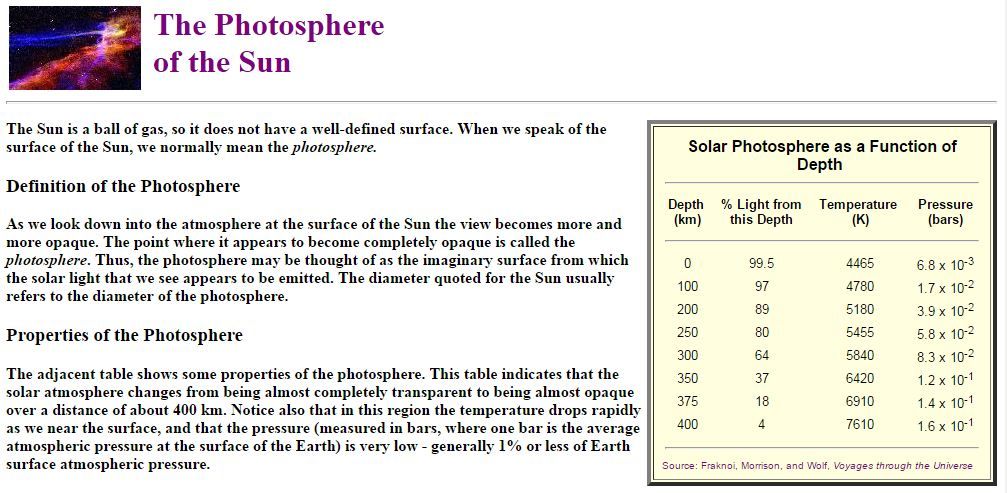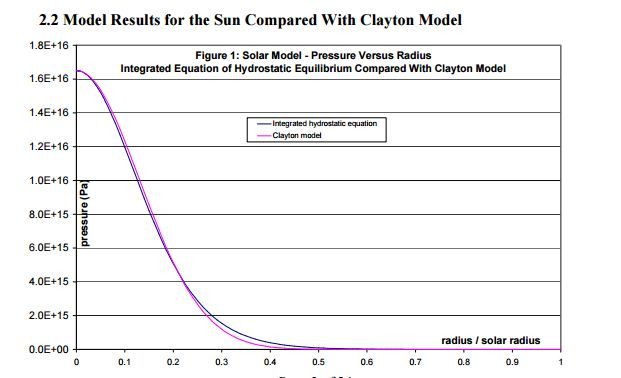rabinoz, I told you to keep your low level stuff out of the upper forums.

The pressure (measured in bars, where one bar is the average atmospheric pressure at the surface of the Earth) is very low - generally 1% or less of Earth surface atmospheric pressure.
Now, the fact that both the photosphere and the cromosphere stay glued next to the surface of a sphere while at the same time they are subjected to an additional enormous centrifugal force, running in the quadrillions of newtons, is what demonstrates clearly the impossibility of a spherically shaped sun.
The gases in both the photosphere and the cromosphere are under a very low pressure.
The force of gravity was taken into consideration, by having balanced out the pressure of the gases.

PRESSURE: 10-13 BAR = 0.0000000000001 BAR
The entire chromosphere will then be subjected to the full centrifugal force of rotation, as will the photosphere itself of course.
Completely unexplained by modern science.
Gravitation that acts in all directions equally leaves unexplained the spherical shape of the sun. As we saw in the preceding section, the gases of the solar atmosphere are not under a strong pressure, but under a very weak one. Therefore, the computation, according to which the ellipsoidity of the sun, that is lacking, should be slight, is not correct either. Since the gases are under a very low gravitational pressure, the centrifugal force of rotation must have formed quite a flat sun.
Solar gravity has balanced out the thermal pressure.
At this point in time the sun will turn into A HUGE GAS CENTRIFUGE WITH NO OUTER CASING, running at some 1,900 m/s.
The Nelson Effect is an established fact of science.
http://www.publish.csiro.au/?act=view_file&file_id=AS06018.pdfPublished in the Publications of the Astronomical Society of Australia, astronomer Dr. Ian Wilson and colleagues from the University of Southern Queensland, prove that Jupiter and Saturn affect the sun's movement and its rotation, and hence its sunspot activity.
We present evidence to show that there
is a direct link between the decreases and increases in
the Sun’s orbital angular momentum about the CM of the
Solar System, and the observed decreases and increases
in the Sun’s equatorial rotation speed. We believe that this
link provides strong circumstantial evidence that there is
a spin–orbit coupling mechanism operating between the
Jovian planets and the Sun. We propose that it is these
changes in the Sun’s rotation speed that are responsible for
variations in the speed of the meridional flow.We postulate
that it is the planetary induced changes in speed of the
meridional flow that control both the duration and strength
of sunspot activity on the Sun’s surface.
The Nelson effect of all the other planets, pulling constantly on the sun's atmosphere, acting permanently, are added to the centrifugal force.
"There has historically been a recognized connection between the frequency of sunspot activity (the total number of spots) and the movement of the sun in relation to solar system's “barycentre” -- or, center of mass. But the big problem is that there is no conventional explanation for exactly how this influence occurs."
The Sun exhibits a variety of phenomena that defy contemporary theoretical understanding.
Eugene N. Parker
It is not coincidence that the photosphere has the appearance, the temperature and spectrum of an electric arc; it has arc characteristics because it an electric arc, or a large number of arcs in parallel.
British physicist C. E. R. Bruce
It is likely that the problem of the dynamics of the explosions affecting the prominences will only be solved when the electrical conditions obtaining in the chromosphere and inner corona are better understood.
Italian solar astronomer Giorgio Abetti
The modern astrophysical concept that ascribes the sun’s energy to thermonuclear reactions deep in the solar interior is contradicted by nearly every observable aspect of the sun.
Ralph E. Juergens
The continuing paradox implies that a different principle, other than mass via gravity interaction, is in operation that produces the observed effects.
Not only the huge centrifugal force is completely unaccounted for, and has no other force to counteract it, thus acting permanently on the atmosphere of the Sun, but now we have the Nelson effect to deal with: if the migration of the sunspots is due to the influence of Jupiter and Saturn, then certainly this influence would change the shape of the Sun to that of a disk.
Let us now attempt to calculate the CORRECT value of g, using the pressure equation and the Clayton stellar model (a nonlinear density curve).
Dr. Clayton was the first astrophysicist to introduce a specific form for ρ(r) which was then subsituted in the hydrostatic equilibrium equation.
Here is the full equation:
P(r) = 2πgr
2a
2ρ
2ce
-x2/3M
where a = (3
1/2M/2
1/24πρ
c)
1/3a = 106,165,932.3
x = r/a
Using P(700,000,000) = 1.0197 x 10
-9 kg/m
2 value, we get:
g = 0,0000507 m/s
2RATIO
a
c/g = 0.0063/0.0000507 = 124.26
Even with the more involved equation, using the Clayton model, g will be much less than the centrifugal acceleration.
If we add the Nelson effect to this, we can see the full nature of the impossibility of a spherically shaped sun paradox.


DO YOU UNDERSTAND THE PHYSICS INVOLVED HERE?
There can be no comparison whatsoever between the centrifugal force and gravity anymore.
Gravity has already balanced out the thermal pressure.
The centrifugal force acts as an ADDITIONAL FORCE, running in the quadrillions of newtons.
Basically, the sun becomes an enormous gas centrifuge with no outer casing.
Since the gases in the both the photosphere and the cromosphere are under a very low pressure, you cannot bring gravity into the discussion anymore.
Those gases then will be subject to the full centrifugal force computed above.
That is why no scientist at the present time can explain the defiance of newtonian mechanics by the gases in the solar photosphere.
Since the gases are under a very low gravitational pressure, the centrifugal force of rotation must have formed quite a flat sun.
The pressure in the chromosphere is 10^-13 bar (0.0000000000001 bar).
You used the WRONG equation!
The correct equation is the HYDROSTATIC EQUILIBRIUM EQUATION.
Since gravity has balanced out the thermal pressure, you have to use THE NEW FIGURE OF 0.0000000000001 BAR in the chromosphere to get the corrrect g value.
YOU HAVE FAILED TO ADDRESS THE CNO CYCLE PARADOX:
https://www.theflatearthsociety.org/forum/index.php?topic=30499.msg1827377#msg1827377 YOU HAVE FAILED TO ADDRESS THE FAINT YOUNG SUN PARADOX:
https://www.theflatearthsociety.org/forum/index.php?topic=30499.msg1775118#msg1775118 (martian faint young sun paradox: not nearly enough time for Mars to have attained a spherical shape)
https://www.theflatearthsociety.org/forum/index.php?topic=30499.msg1707290#msg1707290 (faint young sun paradox)